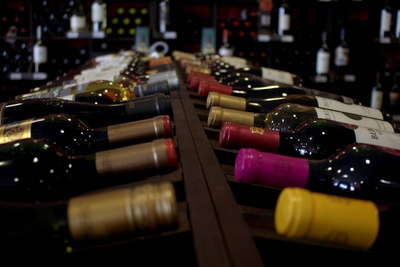What is a Bar Inventory Spreadsheet ?
A bar inventory spreadsheet is a tabular document used to track inventory and inventory turnover at a bar. It can help track different alcohols, beverages and even food stocks. Spreadsheets help keep count of the inflow and outflow of stocks. They help a business get a handle on its costs and help it make better purchasing decisions.
5 Ways an Inventory App Can Beat a Bar Inventory Spreadsheet Hollow
But First, What is a Bar Inventory Spreadsheet?
Before we get to spreadsheets, let's talk a minute to talk about bar inventory and why it's important to all types of barsbe it a small business or a large enterprise. Studies consistently show that restaurants and bars rarely keep inventory. It's not surprising inventory is a tedious and time-consuming task. But avoiding bar inventory can only lead to any one of the following problems- excess stock, deadstock, or stockout. None of which augur well for the bottomline.
Bar inventory is a loathsome, but necessary chore. It helps a business make sure it has enough of what it sells, and manages costs by pointing out what doesn't. This keeps the business organized and profitable.
The way to do bar inventory is to count a bar's stock twice. The time of the first stocktake is called starting inventory , while the second inventory check is called ending inventory . An inventory period has to be fixed. It can a week, fortnight or month, depending on the volume of product and the size of business.
Stockcount has traditionally been done with a bar inventory spreadsheet. This is a tabular sheet with rows and columns. A bar can maintain separate spreadsheets for the different categories of items it wants to inventory.
For example, all liquors could be inventoried on one sheet, all wines on another, and so on. The rows of a liquor spreadsheet could list liquors by brand name. Columns could list details like liquor type, year of manufacture, cost per bottle, quantity, total cost, notes, vendor details or anything else the bar manager might want to add. Stocktake is toting up the bottle count and price over the inventory period to understand how much of a particular liquor has been used during that inventory period and what its costs the bar.
An improvement on paper and pen inventory spreadsheets are digital spreadsheets. These are spreadsheet templates that can be downloaded from Microsoft Excel, Google Spreadsheets or Apple Numbers. The upside of a digital sheet template is that it is far more versatile than paper. Done on a tablet or computer, it allows you to edit inventory data and transfer it via email or the cloud to others. The inventory template can also do limited inventory math if the formulas to calculate cost and sales are fed into the inventory spreadsheet .
Inventory templates are available online for free and can be customized to a bar's requirements. This saves the bar the trouble of creating a spreadsheet from scratch.
starting inventory + received inventory - ending inventory = usage.
Received inventory is the stock that has come in during the inventory period.
A Bar Inventory Spreadsheet Doesn't Work for a Modern Bar. Here's Why

Although bar inventory can be carried out with a spreadsheet template, in today's fast-paced, data-driven world it's not the most efficient method of bar inventory management . The bar inventory spreadsheet is a tool for manual stocktake, and it comes with its fair share of problems.
Human error is the biggest drawback of the bar inventory spreadsheet. A miscount or forgotten product can throw off an efficient inventory and not reflect actual stock. It is also labor intensive and time consuming because it involves having to physically check every item of the stock and meticulously note its details down. The larger or more dispersed the inventory, the more problematic this becomes.
Finally, bar inventory is not only about having to take inventory counts. It also involves forecasting sales to make sure there's enough stock to cater to customers in the near future. The best way to stay ahead of the game is to switch to modern methods of inventory control. And the best way to do that is to upgrade to inventory software for stocktake. Software brings speed, precision and accuracy to bar inventory by automating the process. Most importantly, it provides critical insights into operations that can help minimize losses and maximize profits.
- ZipBartender
- Glimpse Inventory
- Partender
- BarDog
- Bar Cop
- Bar Patrol
- BevSpot
- Bevager
- Barkeep
- WISK

Inventory management doesn’t have to be a mess of bar inventory spreadsheets.
There’s a quicker, more efficient way to take stock. Want to know what it is? This article lays it out for you.
Inventory App Vs. Bar Inventory Spreadsheet- Accuracy

Let's compare the pros and cons of the manual bar inventory system with bar inventory software . The bar inventory spreadsheet needs manual stocktake and the quality of manual stocktake stocktake determines the accuracy of the inventory.
Manual counting is a lengthy, labour-intensive and complex process that is repetitive and boring. (We have yet to meet a stock-taker who has fun on the job.) Stocktaking staff has to note liquor levels accurately, and this is often done by eyeballing, or sizing up a bottle. And because it's repetitive and boring, it's prone to error. A bleary-eyed stock-taker can easily miss or double count bottles .
Accurate stocktake also depends on trustworthy staff, who will not cover up for theft, unauthorised free drinks, or spillage by manipulating the numbers. Then again, assigning staff to manually take inventory is taking them away from other productive tasks. Even though the bar inventory spreadsheet may appear cost-effective, it is more labour-intensive and that itself can add to overheads. Consider this- making staff work extra hours on stock-take days will mean higher labor costs!
Inventory management apps, on the other hand, work in tandem with a raft of other tools to improve the accuracy of inventory counts. Barcode scanners allow the stock-taker to simply scan the barcode on a bottle and the item's details are automatically recorded by the inventory software . In the same way, Bluetooth or Wifi weighing scales and spouts send precise liquor bottle levels to the inventory app. No more fudged data. Automated systems track stocktake by individual staff members, making the inventory process more transparent, and the staff more accountable.
Inventory App Vs. Bar Inventory Spreadsheet- Speed and Volume

One of the benefits of a bar inventory app over an inventory spreadsheet is the speed at which inventory can be done. While using the spreadsheet template, one has to manually take count of the starting inventory , received inventory and ending inventory . But apps make the job easier as the barcodes of the liquor inventory have to only be scanned and their measures noted by the liquor scales to ensure faster inventory counts.
When the turnover of a restaurant is large, the volume of stock used is also large. Taking inventory of such high volumes manually, and entering the data in a spreadsheet is labour-intensive and time-consuming. But an automated bar inventory system will update the liquor inventory every time there's a sale. This cuts down the hours spent to manually update the inventory spreadsheet .
The app can also be customised to a multi-user inventory system and team members can take inventory on multiple devices at the same time to get the job done quickly. Bars with multiple locations will especially benefit from this.
Inventory App Vs. Bar Inventory Spreadsheet- Integration

One of the drawbacks of using a bar inventory spreadsheet is maintaining multiple data spreadsheets for different products categories. The bar manager has to then tally this vast and varied inventory with purchase orders and receipts, and manually calculate variance, pour cost, shrinkage, loss, and so on. This necessitates monitoring and cross-checking different systems at the bar, from ordering to sales point. It also demands regular number-crunching. Superior math skills are crucial to this function! Naturally, the chance of error is high.
But modern inventory software is a whiz at handling large data sets. No matter how sprawling the inventory, a bar inventory management app is adept at monitoring the data. It ensures a First-In-First-Out system to make sure older inventory is finished first. This way, obsolete stock is reduced. A bar inventory app red-flags slow-moving stock to make sure it isn't ordered often. It can issue alerts about depleting stocks and prompt orders when stocks hit par level.
But inventory software does more than just manage inventory count and calculate usage. Integrated with a restaurant's point of sale or pos system inventory management can be streamlined with a restaurant's overarching management software. It can process historical inventory data to forecast sales trends. This way, it helps the business figure out if more or less inventory is needed on a particular day. For example, it can recommend ordering more stock of tequila ahead of National Tequila Day, if sales of tequila showed a spike the previous year.

Technology has come a long way since the bar inventory spreadsheet.
If you want to streamline your inventory management, you need to get with the times. Here’s how . . .
Inventory App Vs. Bar Inventory Spreadsheet- Access
While a bar inventory spreadsheet can be shared via Google Docs, it still has certain drawbacks. It offers limited access to data entry and it needs a user to own a Google account! On the other hand, an app is platform agnostic, and it can grant unlimited access to multiple users for inventory count. Users need only open the app on their tabs or smartphones to conduct stocktake across the bar, or across its multiple locations. Moreover, user controls can be applied by the owner or manager to restrict access to different parts of the bar to whoever it chooses.
Most inventory apps are cloud-based. This allows them to grant business owners and managers access to inventory count from any device, anywhere. A bar manager on holiday in Hawaii can calculate usage, review invoices and prompt vendor orders for their bar in Chicago, from a deckchair on the beach. An app allows a business to keep track of inventory management and make business decisions for the bar from any corner of the globe.
- The order process is streamlined as the bar inventory app will issue alerts about depleting stocks.
- An inventory app helps with sales forecasts, based on past sales trends archived by the POS system.
- The app maintains a First-In-First-Out system to ensure that older inventory is finished first.
- Inventory which is not used often is not ordered frequently.
Inventory App Vs. Bar Inventory Spreadsheet- Analytics

A spreadsheet is a cheap and simple tool to manage inventory and it may serve a small business well if it wants to do no more than count bottles . But it cannot do the heavy lifting that modern bar inventory management demands. Of all the functions an inventory app can accomplish, its ability to use artificial intelligence and analytics to process data and produce reports and forecasts is most valuable.
It can process inventory data to predict sales trends, recommend new menu pricing, and highlight loss-making inventory and bar practices. A bar manager will immediately spot free liquor handouts and catch theft. It can do this with the help of alerts the app issues when inventory levels don't tally with sales. This is sure to stem losses.
Inventory software can also forecast busy periods to ensure that the bar has adequate stock and staff to cater to customers. A business can customise its customer experience by tracking a customer's purchase history and sending them targeted emails based on past purchases. Customers can also be drawn in with alerts on social media pages.
It's evident from this that inventory software isn't confined to the stockroom. It plays a larger role in the modern bar and links with every part of the management system. The upshot- stock count delivers better sales, cuts costs and multiplies profits.

Inventory management can be a pain, and done badly, it can eat away your profits.
Thankfully, there’s something better than a bar inventory spreadsheet to deal with it.
